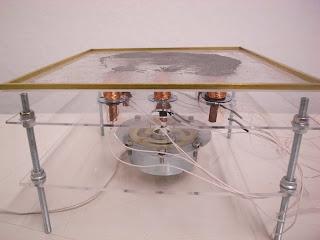Morpholexical Ping Pong @ Society for Nontrivial Pursuits - FEED Soundspace Berlin
11.05.2012
An improvisational dialogue of acoustic misunderstandings and semanto-phonetic morphologies for self-made sensor instruments, live voice and Supercollider. For two players.
We expanded the performance to try and include the computers as players, using the latest edition of Google Chrome and a slightly unreliable applescript, we automated functions of computer-listening and computer-speaking for the computer to join in our dialogue of misunderstandings.
We projected our automatically posted Skype dialogue for the audience to read. Here is a copy of it including errors:
[11/05/2012 21:49:08] Mari Matsutoya: can you when I am not your nano
[11/05/2012 21:49:26] Mari Matsutoya: Translate
From: Detect language
To: English
EnglishSpanishFrench
Type text or a website address or translate a document.
EnglishSpanishArabic
New! Click the words above to edit and view alternate translations. Dismiss
Google Translate for Business:Translator ToolkitWebsite TranslatorGlobal Market Finder
Turn off instant translationAbout Google TranslateMobilePrivacyHelpSend feedback
[11/05/2012 21:49:43] Mari Matsutoya: Translate
From: Detect language
To: English
EnglishSpanishFrench
Type text or a website address or translate a document.
EnglishSpanishArabic
New! Click the words above to edit and view alternate translations. Dismiss
Google Translate for Business:Translator ToolkitWebsite TranslatorGlobal Market Finder
Turn off instant translationAbout Google TranslateMobilePrivacyHelpSend feedback
[11/05/2012 21:50:00] Mari Matsutoya: Translate
From: Detect language
To: English
EnglishSpanishFrench
Type text or a website address or translate a document.
EnglishSpanishArabic
New! Click the words above to edit and view alternate translations. Dismiss
Google Translate for Business:Translator ToolkitWebsite TranslatorGlobal Market Finder
Turn off instant translationAbout Google TranslateMobilePrivacyHelpSend feedback
[11/05/2012 21:50:20] Mari Matsutoya: Translate
From: Detect language
To: English
EnglishSpanishFrench
Type text or a website address or translate a document.
EnglishSpanishArabic
New! Click the words above to edit and view alternate translations. Dismiss
Google Translate for Business:Translator ToolkitWebsite TranslatorGlobal Market Finder
Turn off instant translationAbout Google TranslateMobilePrivacyHelpSend feedback
[11/05/2012 21:50:50] Mari Matsutoya: eddie you
[11/05/2012 21:51:08] Mari Matsutoya: 81
[11/05/2012 21:51:25] Mari Matsutoya: call after you
[11/05/2012 21:51:43] Mari Matsutoya: Translate
From: Detect language
To: English
EnglishSpanishFrench
Type text or a website address or translate a document.
EnglishSpanishArabic
New! Click the words above to edit and view alternate translations. Dismiss
Google Translate for Business:Translator ToolkitWebsite TranslatorGlobal Market Finder
Turn off instant translationAbout Google TranslateMobilePrivacyHelpSend feedback
[11/05/2012 21:52:01] Mari Matsutoya: call of duty on
[11/05/2012 21:52:41] Annie Goh: is this out
[11/05/2012 21:52:53] Annie Goh: epcot
[11/05/2012 21:53:05] Annie Goh: definitely not cry
[11/05/2012 21:53:17] Annie Goh: 7 is fine
[11/05/2012 21:53:30] Annie Goh: even without a condom
[11/05/2012 21:53:56] Annie Goh: delta sonic
[11/05/2012 21:54:08] Annie Goh: delta sonic
[11/05/2012 21:54:20] Annie Goh: ultrasonic
[11/05/2012 21:54:33] Annie Goh: super cala fragilistic expialidocious
[11/05/2012 21:54:45] Annie Goh: yeah that's the plan
[11/05/2012 21:59:04] Annie Goh: how to live
[11/05/2012 22:00:06] Mari Matsutoya: soon soon soon soon the station
[11/05/2012 22:00:25] Mari Matsutoya: Translate
From: Detect language
To: English
EnglishSpanishFrench
Type text or a website address or translate a document.
EnglishSpanishArabic
New! Click the words above to edit and view alternate translations. Dismiss
Google Translate for Business:Translator ToolkitWebsite TranslatorGlobal Market Finder
Turn off instant translationAbout Google TranslateMobilePrivacyHelpSend feedback
[11/05/2012 22:00:34] Annie Goh: save the paper paper paper
[11/05/2012 22:00:58] Mari Matsutoya: tron tron tron tron tron discretion
[11/05/2012 22:01:30] Annie Goh: tron tron tron tron tron question
[11/05/2012 22:01:57] Mari Matsutoya: super super super super super power
[11/05/2012 22:02:23] Annie Goh: testing testing testing testing
[11/05/2012 22:02:51] Mari Matsutoya: how are pop pop pop pop to the station
[11/05/2012 22:03:28] Annie Goh: safe to say that

















